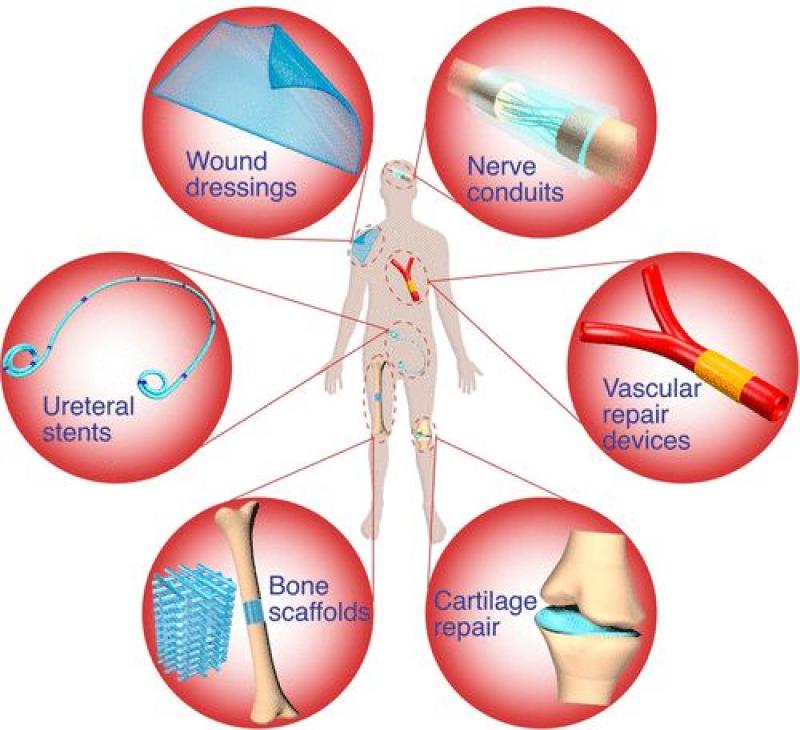Regenerative medicine is a cutting-edge field that aims to restore the structure and function of damaged or diseased tissues and organs. A key component of regenerative therapies is the use of biodegradable scaffolds, which serve as temporary frameworks to support cell growth and tissue regeneration. These scaffolds provide a conducive environment for cells to proliferate, differentiate, and eventually replace the degraded tissue. This article explores the concept, fabrication, and diverse applications of biodegradable scaffolds in regenerative medicine, highlighting their potential to revolutionize modern healthcare.
Understanding Biodegradable Scaffolds
Biodegradable scaffolds are three-dimensional (3D) structures composed of natural or synthetic materials that can be implanted into the body to aid tissue regeneration. The scaffolds are designed to mimic the extracellular matrix (ECM) of the target tissue, providing a suitable microenvironment for cell attachment, migration, and proliferation. As the name suggests, these scaffolds gradually degrade over time, eliminating the need for surgical removal and minimizing potential complications.
Fabrication Techniques for Biodegradable Scaffolds
Various fabrication techniques are employed to create biodegradable scaffolds with precise control over their architecture and properties. Techniques such as electrospinning, 3D bioprinting, and freeze-drying allow researchers to customize scaffold characteristics like porosity, pore size, mechanical strength, and degradation rate. The choice of fabrication method depends on the intended application and the specific tissue or organ being targeted for regeneration.
Biodegradable Scaffolds in Bone Tissue Engineering
Bone defects resulting from trauma, diseases, or congenital abnormalities pose significant challenges to traditional treatments. Biodegradable scaffolds offer a promising solution in bone tissue engineering by providing a scaffold structure conducive to bone cell growth and mineral deposition. Incorporation of bioactive factors and osteoconductive materials further enhances bone regeneration. The ability of biodegradable scaffolds to gradually transfer mechanical loads to the regenerated bone also contributes to better long-term outcomes.
Applications in Cartilage Repair and Regeneration
Cartilage has limited regenerative capacity, making cartilage injuries or degeneration difficult to treat. Biodegradable scaffolds have shown immense potential in cartilage tissue engineering by providing mechanical support and guiding chondrogenic differentiation of cells. The combination of these scaffolds with mesenchymal stem cells and growth factors can promote the formation of functional cartilage tissue, offering hope for patients with osteoarthritis and cartilage defects.
Biodegradable Scaffolds in Nerve Regeneration
Nerve injuries and peripheral nerve disorders often result in permanent disabilities. Biodegradable scaffolds designed to support nerve regeneration facilitate the alignment and elongation of nerve cells, guiding axonal growth across the injury site. These scaffolds may be combined with supportive cells, such as Schwann cells, to enhance nerve regeneration and functional recovery. As research progresses, biodegradable scaffolds hold potential applications in repairing the central nervous system as well.
Cardiac Tissue Engineering with Biodegradable Scaffolds
Cardiovascular diseases remain a leading cause of mortality worldwide. Biodegradable scaffolds offer innovative approaches to cardiac tissue engineering and regeneration. Scaffolds seeded with cardiac cells can facilitate the formation of contractile tissue, which may be integrated into the damaged heart, potentially improving cardiac function and reducing the need for heart transplantation.
Challenges and Future Perspectives
Despite their tremendous potential, biodegradable scaffolds face certain challenges, including maintaining structural integrity during the critical early stages of tissue regeneration and controlling the scaffold degradation rate to match tissue formation. In addition, ensuring that the scaffold's degradation byproducts are biocompatible and do not evoke inflammatory responses is crucial. Advancements in biomaterial science, scaffold design, and cell-based therapies are likely to address these challenges and pave the way for widespread clinical applications of biodegradable scaffolds in regenerative medicine.
Conclusion
Biodegradable scaffolds represent a promising and versatile platform in regenerative medicine. Their ability to provide temporary structural support while promoting tissue regeneration opens up exciting possibilities for addressing a wide range of medical conditions and improving patient outcomes. Continued research and collaboration between scientists, clinicians, and industry partners will undoubtedly lead to further advancements in biodegradable scaffold technology, driving the transformation of modern healthcare and offering new hope to patients with previously untreatable conditions.
